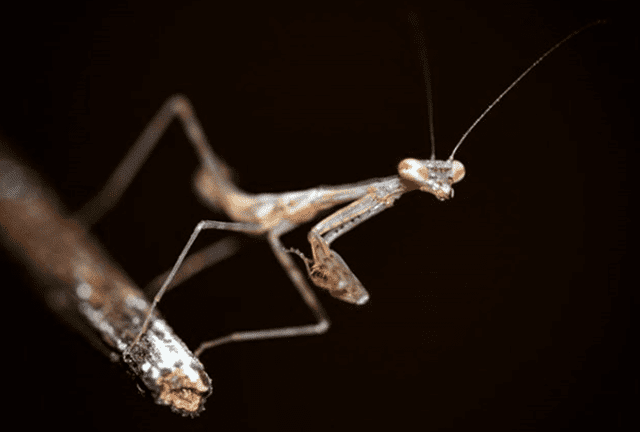General:
Praying mantises are lurking hunters. They often hang motionless for days, there to grab at the decisive moment. It does not matter how much faster a fly can move, it depends on this one moment. The moment that decides whether a fly is eaten or eaten.
The Miomantis paykullii behaves a little bit different than its conspecifics and that makes it a very interesting mantid in my opinion. The very agile mantids do not hang, as usual, only at one place in the terrarium, but they look for several different places. Miomantis paykullii are relatively small and also jumpy mantids. In case of danger Miomantis flees away with fast jumps. The males are very agile and good flyers and use this regularly when escaping.
For a lurking hunter, it often actively catches prey, which in other species can only be seen in very hungry mantids. Watching a mantis hunt is enormous fun and also brings one a welcome change. Therefore I can not only recommend Miomantis paykullii to every beginner but I think you should have kept them at least once.
Size / Life expectancy:
Male: 3.5 cm / Total 4 months (2 months to adult + 2 months as adult).
Female: 4.0 cm / Total 6 months (2 months to adult + 4 months as adult)
Food:
Natural Habitat:
Miomantis paykullii inhabits steppes and dry areas in Africa, where it perches on shrubs, bushes and grasses. The distribution area is huge with Egypt, Burkina Faso, Ivory Coast, Ghana, Cameroon, Kenya, Mauritania, Mozambique, Niger, Senegal, Chad, Togo, Uganda and Zimbabwe. This is also, as with all easy to keep mantids, a good indication that the species does not specialize in any particular condition, but is relatively insensitive to variation.
Keeping in a Insectarium:
L1-L3:
It is best to incubate the ootheca in a BraPlast box. Then you save the trouble of moving the animals, which is no fun with Miomantis paykullii due to their agile nature. In the lid I cut out an opening and used organza with hot glue as a ventilation grid. On the side I added a ventilation for safety. At the beginning I take untreated wood wool as climbing possibilities and as ground kitchen towels. There must always be twice the size of the mantids at the bottom, so that the moulting can proceed smoothly. You should keep the nymphs a bit more humid than the bigger animals. Every 2-3 days I spray the substrate a little bit. When spraying it is better to start a little more carefully and approach slowly. Waterlogging is more dangerous for your animal than a little lower humidity. There should always be enough Drosophilas as food supply in the container. I change the kitchen towel at least once a week, depending on how high the stocking density is.
from L4:
Due to their realtively pronounced intraspecific aggressiveness, I place them individually from L4 and can recommend everyone to do the same. On the subject of terrarium size I go into more detail in the article “Terrarium size and ventilation”. You are also welcome to watch the video to the article.
Reproduction:
Sex determination:
Sex determination can only be done reliably from L5 onwards. Only the number of segments provides reliable information for Miomantis paykullii. The male Miomantis paykullii have 8 segments and the female only 6.
An absolutely fascinating feature of Miomantis paykullii is that it can reproduce by parthenogenesis. By the virgin production only a few offspring are produced, but this is still much more than in most other species where this is not possible. Therefore even one female Miomantis paykullii is enough to get offspring to secure this species in the population.
If you want to know more about sex determination, you can read the article Sex determination of a praying mantis.
Sexual maturity:
Females need 1-2 weeks after the mature molt until they are ready to mate. Males only 1 week. If you recognize the sex from L5, you can keep the males a little cooler for safety.
Even with the same housing conditions it is possible to get both sexes adult and mate at the same time.
Mating:
Breeding is relatively easy, about two weeks after the adult molt you put male and female together and wait, the females should be well fed as always.
As soon as a male is near a female, he immediately jumps on the female’s back without watching the female first or waiting for the right moment. Even if the female tries to eat the male, the male jumps on the female’s back so quickly and skillfully that the male can almost always escape.
Oothec deposit:
One ootheca can contain up to 70 eggs, although the average is 20-40 eggs. In contrast to the free ootheca of cockroaches, praying mantises glue their roundish, elongated, shield-like, teardrop-shaped or parcel-like ootheca to various substrates. They are often attached to climbing surfaces or to the gauze lid. To do this, they first apply a proteinaceous secretion to the substrate. Under spiral movements of the abdomen, more of this foamy secretion is now released, whereby the eggs are now deposited one after the other into the same in such a way that they are in a certain arrangement to each other and occupy one compartment of the ootheca each. Finally, the secretion is drawn out in a more or less long thread before it hardens into a sponge-like, very firm cocoon. Along the surface lies the thinnest-walled area from which the nymphs hatch. It can usually be seen as a large-pored, seam- or comb-like strip. More about the ootheca can be found here.
Incubation:
The hatching is strongly coupled to the temperature, at 27° C the nymphs hatch after about 3 weeks. It is recommended to spray every 2-3 days.




